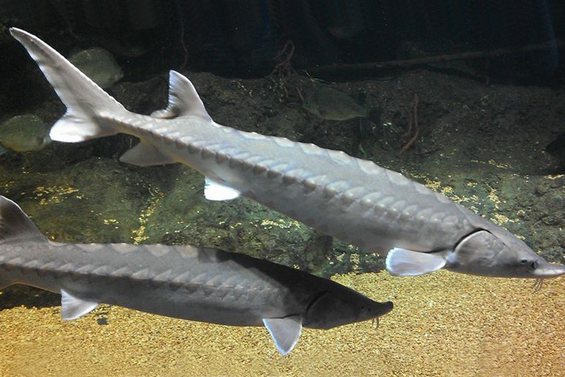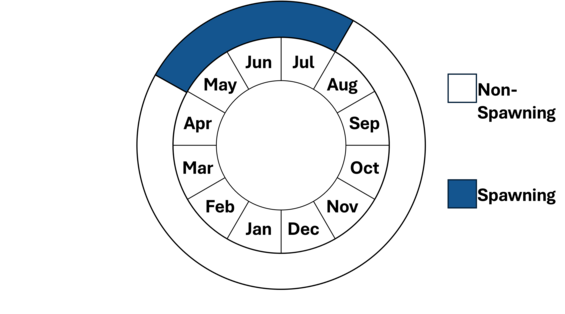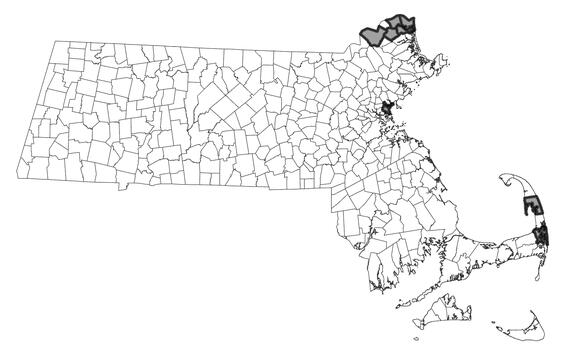- Scientific name: Acipenser oxyrinchus
- Species of Greatest Conservation Need (MA State Wildlife Action Plan)
- Endangered (MA Endangered Species Act)
- Endangered/Threatened (US Endangered Species Act)
Description

Atlantic sturgeon (Acipenser oxyrinchus)
The Atlantic sturgeon is a very large prehistoric-looking fish, averaging 1.8 to 2.8 m (6 to 9 ft) in length, but sometimes exceeding 4 m (13 ft) in length and 363 kg (800 lbs). Adults possess a long, pointed snout and a narrow subterminal mouth with four fleshy barbels. The species has five rows of bony plates called scutes along the body (dorsally, laterally, and ventrally) and modified armored scales on the head giving it a skull-like appearance. The dorsal row of scutes is often white at the tips. Body coloration varies from olive green, blue, and black with a white underside.
The Atlantic sturgeon can be confused with the smaller shortnose sturgeon. Features that distinguish these species include the Atlantic sturgeon’s presence of scutes between the base of the anal fin and lateral row of scutes, and narrower mouth relative to interorbital width.
Life cycle and behavior

Atlantic sturgeon migrate into freshwater rivers from April to May, moving on spawning sites from June through July. Males generally migrate upstream earlier than females. Spawning occurs in flowing water over rocky substrates, often just above the salt front (the border between freshwater and saltwater). Little is known about sturgeon spawning, but egg fertilization is external. The eggs are very adhesive and attach to rocks and plants. Spawning fish can sometimes be seen leaping and splashing. Females migrate back to the ocean soon after spawning, but males may remain in fresh and estuarine habitat until colder weather arrives in the fall. Juvenile Atlantic sturgeon are active swimmers and remain in freshwater habitats feeding for some time but gradually move seaward as they mature, migrating out to sea between their second and sixth year. Non-spawning sturgeon occupy lower freshwater and estuarine reaches of the Merrimack River from May to October and can spend time in Massachusetts coastal waters between April and February. Female Atlantic sturgeon do not spawn until they are at least 10 years old and over 150 lbs., whereas males often begin spawning younger when they are only 32 kg (70 lbs). Although spawning runs occur every year, individuals do not spawn annually. Males spawn at intervals of 1 to 5 years and females spawn at intervals of 3 to 5 years. They can live up to 60 years. Atlantic sturgeon are benthic feeders, consuming worms, amphipods, isopods, shrimps, mollusks, and sand lance.
Population status
Atlantic sturgeon is listed as endangered in Massachusetts. As with all species listed in Massachusetts, individuals of the species are protected from take (picking, collecting, killing, etc.) and sale under the Massachusetts Endangered Species Act. The species is also federally listed under the United States Fish and Wildlife Service as endangered for the New York Bight distinct population segment and as threatened for the Gulf of Maine distinct population segment.
Distribution and abundance
The Atlantic sturgeon range extends from Florida to the St. Lawrence River inhabiting coastal marine, estuarine, and larger river systems. In Massachusetts, Atlantic sturgeon occur in the lower Merrimack River and along coastal Massachusetts. Historically, the species was recorded in the lower Taunton River and other estuarine segments of large rivers. The species occupies the Connecticut River as well, but its current distribution does not extend into Massachusetts. Currently, no reproduction occurs in Massachusetts and is confined to the Kennebec River system in Maine, and very limited reproduction in the lower Connecticut River and other large rivers to the south (e.g., Hudson, Chesapeake Bay). Historically, the Merrimack River and Taunton River supported habitat for reproduction. However, habitat fragmentation from impassable dams, habitat alteration, and degraded water quality likely extirpated these reproduction sites and individuals. Currently, the estuarine habitat of the lower Merrimack River is a likely foraging area for the Gulf of Maine population segment. Further, other embayments from Cape Ann to Cape Cod are likely important foraging habitats for the species. Atlantic sturgeon captured, tagged, and released in the Merrimack River have been recorded from as far north as the Bay of Fundy, several rivers in Maine, and as far south as the James River in Virginia. Most individuals stay within the Gulf of Maine. Infrequent coastal observations of Atlantic sturgeon are typically reported from carcasses washed up on beaches and accidental hooking from recreational marine anglers.

Distribution in Massachusetts. 2000-2025. Based on records in the Natural Heritage Database.
Habitat
The Atlantic sturgeon is an anadromous fish, spawning in fresh and brackish water and spending much of its adult life in estuarine or marine coastal habitats. Adults spawn over rocky substrate and juveniles stay within natal freshwater and brackish habitat for 2-6 years.
Healthy habitats are vital for supporting native wildlife and plants. Explore habitats and learn about conservation and restoration in Massachusetts.
Threats
The primary threats to Atlantic sturgeon are fragmentation of historic spawning freshwater habitat from dams, water quality degradation from chemical pollution, vessel strikes, bycatch from commercial fishing, and dredging of estuarine habitats. Atlantic sturgeon are particularly vulnerable to these threats because of their delayed late age at maturity and their expansive habitat use of freshwater, estuarine, and coastal habitats to maintain viable populations.
Conservation
Atlantic sturgeon are monitored through survey efforts by federal (USGS) and state agency partners (Connecticut DEEP), and during in-water construction activities. Survey efforts often tag suitable individuals for future tracking.
Protection and restoration of shortnose sturgeon habitat and mortality minimization is critical for shortnose sturgeon persistence and recovery. This is achieved by working with state and federal partners, conservation organizations, and hydroelectric companies to improve streamflow and habitat conditions. Further stress and mortality are avoided during in-water construction activities (e.g., dredging, riverbank work, bridge construction) through the development of Atlantic sturgeon protection plans.
Research efforts needed for Atlantic sturgeon include determining sturgeon distribution and habitat use in coastal rivers and other coastal migration corridors around the Massachusetts coast; determination of population genetic structure for sturgeon using Massachusetts waterbodies (Gulf of Maine population segment); and continued monitoring of known river and estuarine reaches used by Atlantic sturgeon.
References
Kieffer, M. C., & Kynard, B. 1993. Annual movements of Shortnose and Atlantic sturgeon in the Merrimack River, Massachusetts. Transactions of the American Fisheries Society 122:1088–1103.
Kieffer, M. C.; Kynard, B.; Seibel, D., 2012: Foraging and wintering ranges and the effect of tidal and diel cycles on movement of shortnose sturgeon with a note on sub-adult Atlantic sturgeon. WSCS Spec. Publ. No. 4. pp. 115–127.
Kynard, B., M. Horgan, M. Kieffer. 2000. Habitats used by Shortnose sturgeon in two Massachusetts rivers, with notes on estuarine Atlantic sturgeon: a hierarchical approach. Transactions of the American Fisheries Society 129:487-503.
Pendleton, R.M., and R.D. Adams. 2021. Long-term trends in juvenile Atlantic sturgeon abundance may signal recovery in the Hudson River, New York, USA. North American Journal of Fisheries Management 41:1170-1181.
Savoy, T., Maceda, L., Roy, N. K., Peterson, D., & Wirgin, I. 2017. Evidence of natural reproduction of Atlantic sturgeon in the Connecticut River from unlikely sources. PLoS ONE, 12(4).
Stein, A.B., K.D. Friedland, M. Sutherland. 2004. Atlantic sturgeon marine bycatch and mortality on the continental shelf of the Northeast United States. North American Journal of Fisheries Management 24: 171-183.
Stein, A.B., K.D. Friedland, M. Sutherland. 2004. Atlantic sturgeon marine distribution and habitat use along the Northeastern coast of the United States. Transactions of the American Fisheries Society 133:527-537.
Wippelhauser, G.S., J. Sulikowski, G.B. Zydlewski, M.A. Altenritter, M. Kieffer, M.T. Kinnison. 2017. Movements of Atlantic sturgeon of the Gulf of Maine inside and outside of the geographically defined distinct population segment. Marine and Coastal Fisheries: Dynamics, Management, and Ecosystem Science 9:93-107.
Contact
| Date published: | April 9, 2025 |
|---|